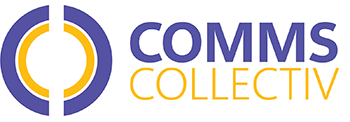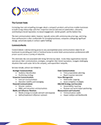CollectivNews
Welcome to a monthly round-up of information relevant
to comms professionals and everyone interested in the fractional model.
April 2025

Winging It: My First Fractional Comms Role Taught Me I Don’t Need to Rule the Roost
Why was I running around a manufacturing plant with a giant inflatable chicken, talking to employees in three languages about the importance of quality?
Because fractional communications work takes you places — from the C-suite to the coop.
Fractional roles are gaining traction in tech and consulting. But for the past six months, I found myself deep in America’s food supply chain — helping transform employee communications for 21,000 associates at an iconic U.S. agribusiness.
Yes, that included climbing grain elevators, holding chicks in hatcheries, and translating quality messaging with operations teams that had never worked with a comms lead before.
Unscrambling the Messaging
The company had just launched its first new quality policy since 1992. The CEO made it clear: every employee — from farmers to plant-floor associates — needed to understand how their role impacted quality.
This wasn’t just about compliance. It was about culture. For a 105-year-old brand, quality isn’t just a business imperative — it’s their promise.
But the message wasn’t landing with the people doing the work.
I thought about Daisy, a first-shift operator with 25 years of experience making chicken nuggets at a plant near me in Charlotte. How do I reach her?
Hatching a Better Plan
I started with the audience: Where are they? What do they care about? How do they communicate?
Then I built a new campaign: Quality Begins With Me — centered on real employees: their voices, their languages, their stories.
In six months, we moved from “policy on a slide” to an enterprise-wide movement, including:
— Leadership visits to plants — not just emails
— Quality Begins with Me translated across multiple languages
— Associates featured in storytelling to show ownership
— A video series, intranet articles, signage, talking points — the whole gamut
The Fractional Pecking Order
The $10B privately held AG company was looking for someone to relocate to a small town on the East Coast. After their search for an internal comms leader took longer than normal, they became more open to filling the role with fractional talent, so that’s where I came in.
With me, they got a comms lead who could jump in fast and deliver, and I got the flexibility to do meaningful work in 20 hours a week — and still live my life.
Leading fractionally means flexing fully. Sure, I wasn’t always calling the shots — I was embedded into the team, sometimes taking detailed direction, building decks, and handling tasks that felt like more junior work I hadn’t touched in over a decade. But I embraced it — because that kind of flexibility was a win/win for both the company and me.
The Takeaway
Fractional communications is a smart, strategic way to do business. For the company, it meant gaining a seasoned professional with experience writing for CEOs, transforming communications models to resonate with employees at every level, and a proven track record of helping thousands of employees see their place within a 100-year legacy of quality.
For me, fractional work offered the perfect blend of flexibility and challenge that I was seeking.
I did not need to be on staff full time to make an impact. I needed a clear strategy, a little humility…and maybe one giant inflatable chicken.
Brad Gorman is a communication executive with more than20 years of experience shaping the reputation of iconic brands like GM, Whirlpool, and KitchenAid. He now does fractional communications work — and writes bios in the third person.

The Rise of Fractional In Uncertain Times
In uncertain times, experience and flexibility offer both reassurance and effectiveness. This may explain the continued rise of fractional hiring.
A June 2023 article from Catalant, a platform that connects companies with vetted independent consultants, highlighted the rise of fractional executives. Citing data from the Bureau of Labor Statistics, it noted that temporary business management roles increased by 18% from 2021 to 2022—and by 57% since 2020.
Catalant’s own analysis also showed an increased demand for fractional roles noting,” When critical skills are hard to come by and resources are tight, hiring an experienced specialist on a dynamic, part-time basis allows for far more flexibility in the face of uncertainty. We most often see this type of work in PE-backed companies doing turnaround transformational work, M&A, capital raises, and cases where the experience of someone who has ‘been there, done that,’ is desired, but without the full-time need.”
The three use cases cited in the article align with what we commonly see at CommsCollectiv, though they only begin to scratch the surface:
Filling a role during a search
Using fractional executives for roles that are important, but not full-time
Taking a “try before you buy” approach (if the talent is open to full-time)
All Things Innovation summed it up perfectly: “Fractional employment is not just a trend but a strategic approach to talent management in the modern workplace…fractional hires offer a way to access the experience and skills needed to fuel growth without the overhead of full-time executive positions. As this employment model continues to evolve, it will likely become an integral part of how companies think about staffing and innovation in the future.”

ChatGPT’s 4o Image Generation Shows Just How Fast AI Is Moving
Imagine an AI system sifting through your employees’ weekly emails to pinpoint who’s pulling their weight and where there’s slack. That’s the bold idea reportedly brewing at the Department of Government Efficiency (DOGE), using AI to analyze
The launch of ChatGPT’s new 4o Image Generation feature isn’t just a product update — it’s a snapshot of how quickly AI is evolving.
Only a year ago, image generation models were still struggling with hands, faces, and especially text. Now, with 4o, users can generate beautifully detailed images in seconds, revise them with natural language, and even include clear, readable text—a major improvement over past models.
One prompt — “draw this in the style of Studio Ghibli” — took off almost instantly. Within hours of the release, timelines were filled with soft backgrounds, rounded faces, and the warm lighting that defines the Ghibli aesthetic. It went viral not because it was random, but because it was designed to delight.
As Sam Altman shared in a tweet:
“believe it or not we put a lot of thought into the initial examples we show when we introduce new technology.”
That thoughtful rollout worked. But maybe a little too well.
The demand was so overwhelming that OpenAI had to temporarily pause the feature.
Altman responded candidly:
“it’s super fun seeing people love images in chatgpt. but our GPUs are melting.
we are going to temporarily introduce some rate limits while we work on making it more efficient. hopefully won’t be long!
chatgpt free tier will get 3 generations per day soon.”
→ Tweet
Still, that’s part of the story. The fact that people expect this kind of experience from ChatGPT — and rush to try it — shows how much the bar has shifted. We’re no longer surprised that AI can create something beautiful. We expect it to do it in seconds, and we expect to be able to iterate with ease.
It’s another reminder that what’s considered advanced today will likely feel normal a month from now. 4o’s image generation isn’t just better—it’s a glimpse of where things are headed: faster, smarter, more intuitive, and tightly integrated into how we create.
And yes, we tried it, too as you can see from the image below. The results? You be the judge.


